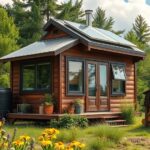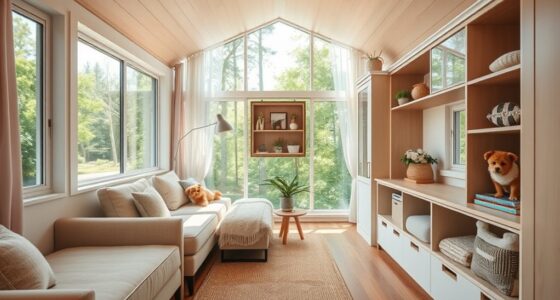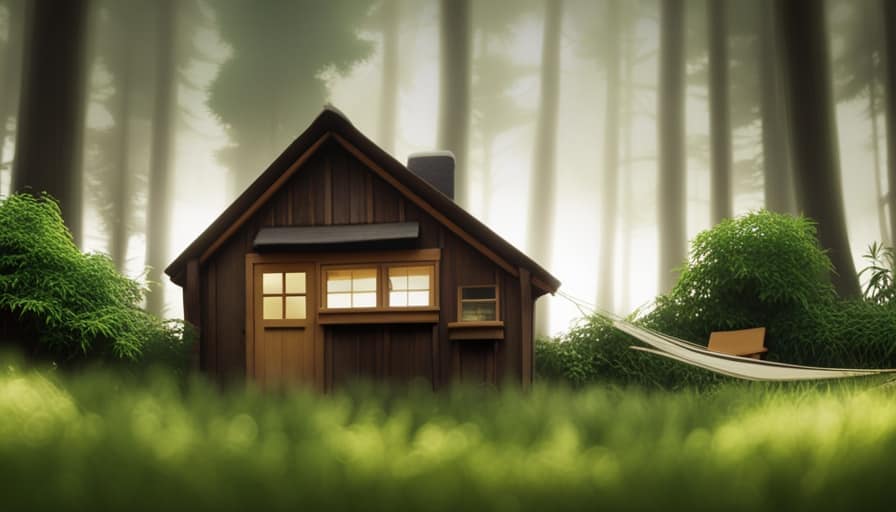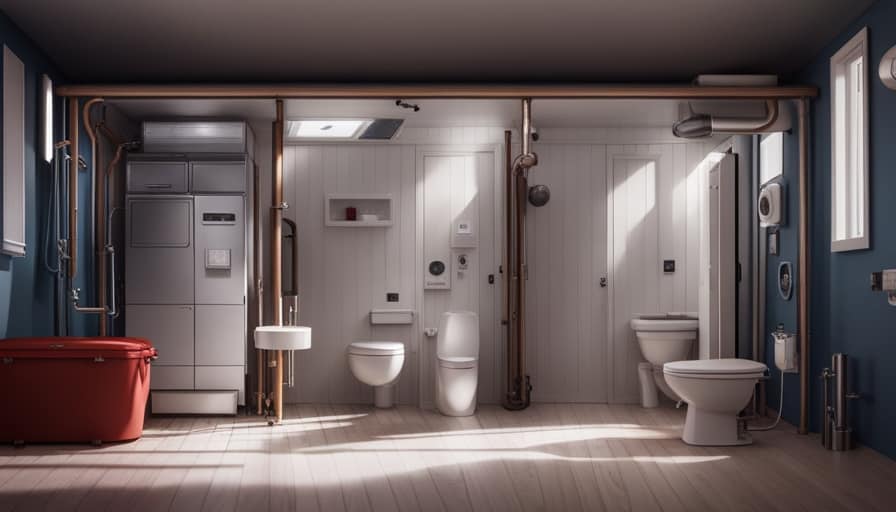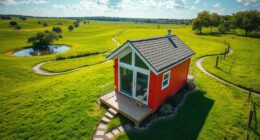Are you prepared to transform your small house with solar power? In this article, our team of experts will help you navigate the steps to mastering the micro-grid.
From assessing your energy needs to connecting the solar system to house electricity, we will provide you with the technical know-how you need to harness the power of the sun.
Get ready to take control of your energy consumption and serve both your house and the environment.
Let’s dive in!
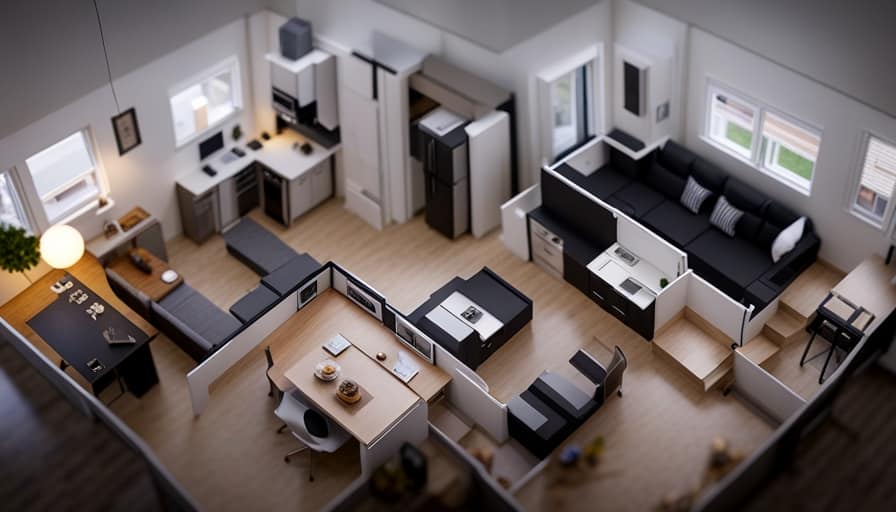
Key Takeaways
- Calculate energy consumption and conduct an inventory of electrical devices to determine total energy load.
- Prioritize energy efficiency by choosing energy-efficient appliances and LED lighting.
- Choose the right solar system considering power requirements, budget, scalability, available space, and maintenance options.
- Source sustainable equipment from reputable suppliers and prioritize eco-friendly equipment procurement.
Assessing Your Energy Needs
We’ll start by determining our energy needs for the tiny house. Calculating our energy consumption is an essential step in designing an efficient and sustainable micro-grid system.
To accurately assess our needs, we must consider various factors such as the number of appliances, their power requirements, and the average daily usage. By conducting an inventory of our electrical devices, we can determine the total energy load. This information will guide us in selecting the appropriate solar panels and battery storage capacity.
In addition to calculating consumption, we must also focus on energy efficiency. Choosing energy-efficient appliances, utilizing LED lighting, and implementing smart energy management systems will help optimize our energy usage. By prioritizing energy efficiency, we can reduce our reliance on the grid and contribute to a greener, more sustainable future.
Choosing the Right Solar System
To ensure optimal energy production, we need to consider our specific power requirements and budget when choosing the right solar system for our tiny house.

When evaluating costs, we must determine the initial investment as well as the long-term savings. It’s important to consider the scalability of the system, ensuring that it can be expanded in the future if our energy needs increase.
Additionally, we need to assess the available space on our property for solar panels and choose a system that fits within those constraints.
Lastly, we should consider the maintenance and warranty options provided by the solar system manufacturer.
By carefully evaluating these factors, we can select a solar system that meets our needs and budget.
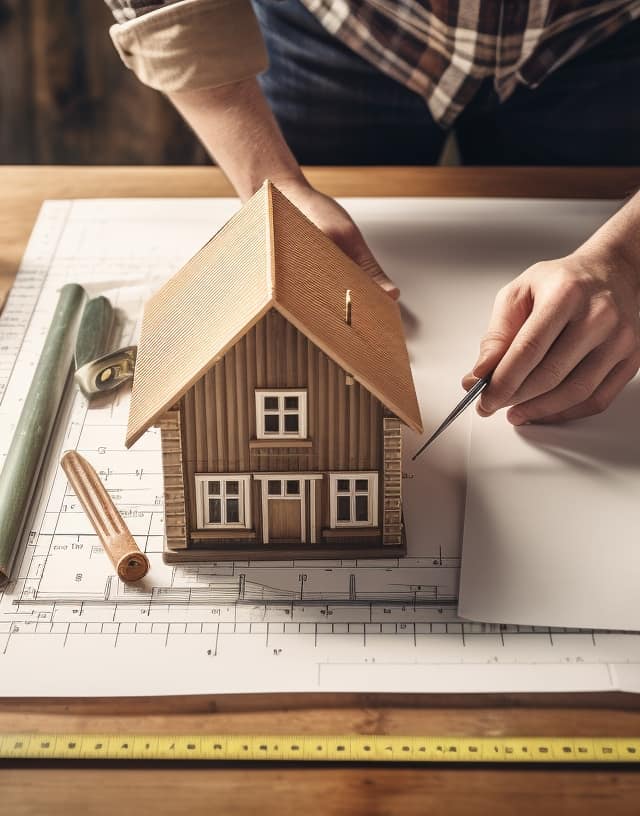
With the right solar system in place, we can move on to procuring the necessary components for our micro-grid setup.
Procuring the Necessary Components
When it comes to setting up a micro-grid in your tiny house, there are several essential components that you’ll need to procure.
These components include:
- Solar panels
- Batteries
- Charge controllers
- Inverters
It’s important to source sustainable equipment that’s designed specifically for off-grid or grid-tied solar systems to ensure optimal performance and efficiency.

Essential System Components
Let’s start by discussing the key components needed to build a reliable micro-grid system for your tiny house. Here are the essential system components you’ll need to consider:
- Solar Panels: These are the backbone of your micro-grid system, converting sunlight into usable electricity.
- Batteries: To store the excess energy generated by your solar panels, you’ll need a reliable battery bank.
- Inverter: This device converts the direct current (DC) from your solar panels and batteries into alternating current (AC) for your appliances.
- Charge Controller: This component regulates the flow of electricity between your solar panels, batteries, and inverter, ensuring optimal charging and preventing overcharging.
Assessing the energy efficiency and integrating renewable sources are key steps in building a sustainable micro-grid system.
Now that we understand the essential components, let’s move on to the next section: sourcing sustainable equipment.
Sourcing Sustainable Equipment
We recommend starting with two key steps: researching reputable suppliers and comparing prices when sourcing sustainable equipment for your micro-grid. It’s important to prioritize eco-friendly equipment procurement to ensure that your tiny house operates efficiently and in harmony with the environment.
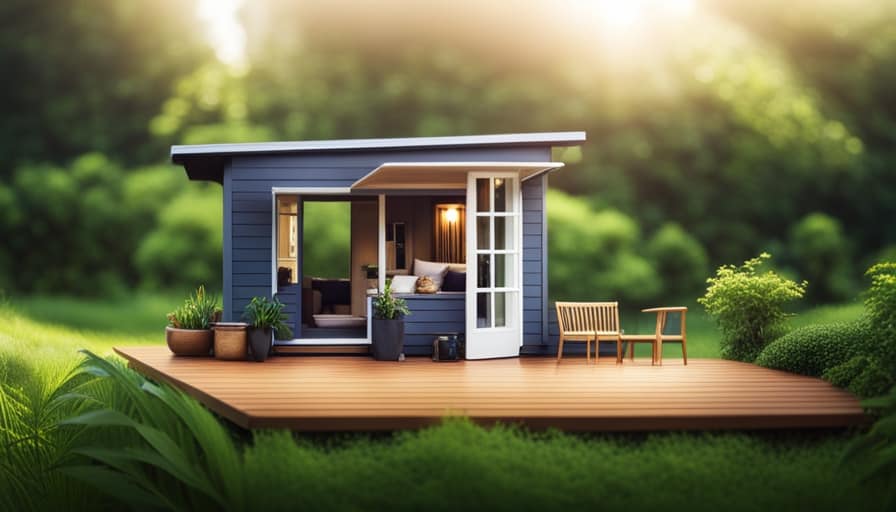
Look for suppliers who specialize in sustainable energy solutions and offer a wide range of products to meet your specific needs. Consider factors such as the durability, efficiency, and lifespan of the equipment before making your final decision. Additionally, comparing prices will help you find the best deal without compromising on quality.
Once you have procured the necessary components, the next step is to position the solar panels effectively to maximize their exposure to sunlight and optimize energy generation.
Positioning the Solar Panels Effectively
When it comes to positioning solar panels effectively, there are a few key points to consider.
First, optimal panel placement is crucial for maximizing solar energy absorption. This means positioning the panels in a location that receives the most sunlight throughout the day.
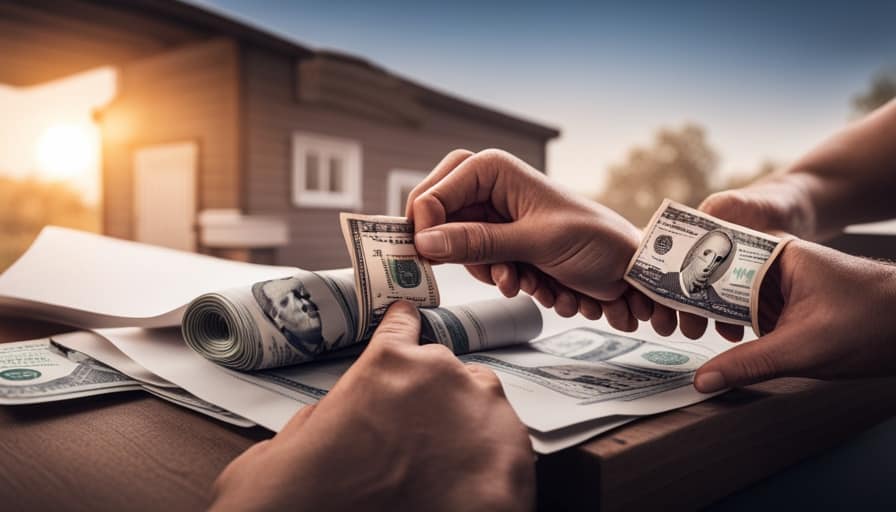
Additionally, considering factors such as shading from nearby trees or buildings can help ensure that the panels are able to capture as much sunlight as possible.
Optimal Panel Placement
To ensure maximum efficiency, place the solar panels in a way that allows for optimal sunlight exposure throughout the day. Here are some key factors to consider when positioning your solar panels:
-
Orientation: Position the panels facing south in the Northern Hemisphere or north in the Southern Hemisphere to receive the most sunlight.
-
Tilt angle: Adjust the tilt angle of the panels based on your location’s latitude to maximize their exposure to the sun.
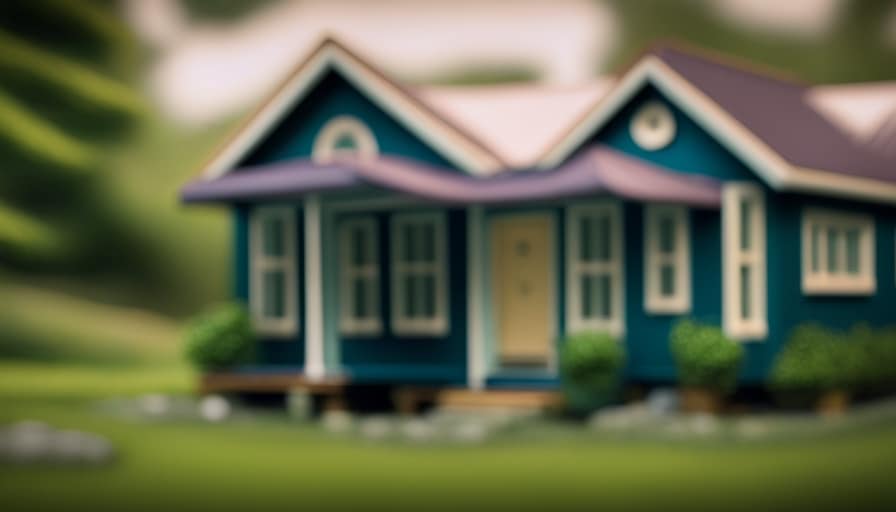
-
Shading: Avoid any potential shading from nearby objects like trees or buildings, as it can significantly reduce the panels’ performance.
-
Solar tracking: Consider using solar tracking systems that automatically adjust the position of the panels throughout the day to follow the sun’s path.
Maximizing Solar Energy
Let’s ensure we position our solar panels strategically to maximize solar energy production in our tiny house. Maximizing efficiency is crucial to make the most of the limited space available on our rooftop.
First, consider the orientation of the panels. Ideally, they should face south to receive maximum sunlight throughout the day. Additionally, the tilt angle should be adjusted according to our latitude to optimize energy absorption.

Regular solar panel maintenance is also essential for optimal performance. Keep the panels clean and free from debris, as dirt or dust can reduce their efficiency. Inspect the panels regularly for any damage or shading caused by nearby objects.
Wiring the Solar System
How can we efficiently wire the solar system in our tiny house to maximize power generation and utilization?
-
Start by mapping out the electrical layout: Identify the key components such as solar panels, charge controllers, batteries, and inverters, and plan their placement accordingly.
-
Use appropriate wire gauge: To minimize power loss and ensure safety, choose the right wire gauge for each component based on the distance and current requirements.
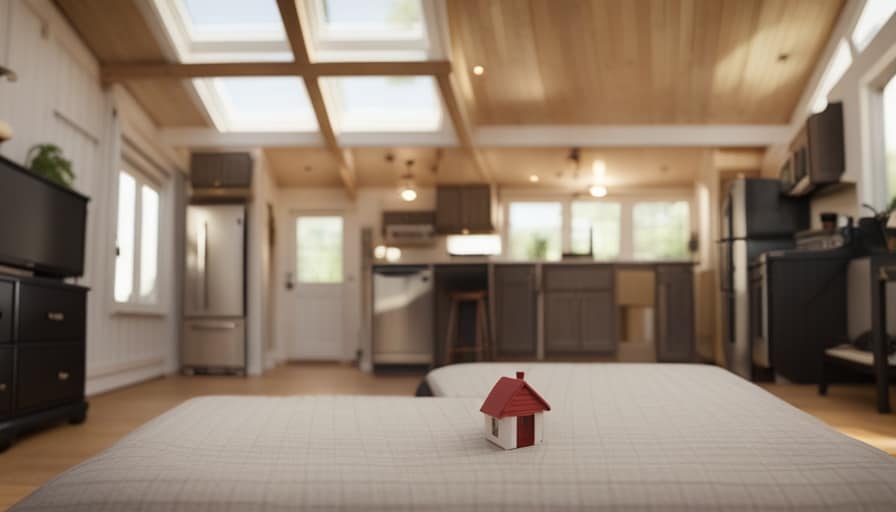
-
Implement proper grounding: Grounding is crucial to protect against electrical faults and ensure the system operates smoothly. Follow the National Electrical Code guidelines for grounding.
-
Label and document all connections: Proper labeling and documentation of connections will make it easier for future solar system maintenance and troubleshooting common issues.
Installing the Inverter
With careful planning and proper placement, we can easily install the inverter in our tiny house solar system. The inverter is an essential component that converts the direct current (DC) electricity produced by the solar panels into alternating current (AC) electricity that can power our appliances. When installing the inverter, it is important to consider a few troubleshooting tips. Firstly, ensure that the inverter is properly grounded to avoid electrical hazards. Additionally, double-check the connections to ensure they are secure and tight. Understanding inverter efficiency is also crucial. Efficiency refers to how well the inverter converts the DC electricity into AC electricity. Look for inverters with high efficiency ratings, as this will maximize the energy output of our solar system. Consider the following table for a comparison of different inverter options:
| Inverter Model | Efficiency Rating |
|---|---|
| Model A | 95% |
| Model B | 98% |
| Model C | 92% |
Setting Up the Battery System
We can start by connecting the batteries in parallel using a series of cables and a coordinating junction box. This setup helps to increase the battery bank’s capacity and provide a more reliable power supply for your tiny house.

When it comes to battery maintenance, there are a few key things to keep in mind. Regularly check the battery voltage and electrolyte levels to ensure they’re within the recommended range. Clean the battery terminals and connections to prevent corrosion and ensure a good electrical connection. It’s also important to avoid overcharging or deep discharging the batteries, as this can significantly reduce their lifespan.
Proper maintenance will help maximize the battery lifespan and ensure reliable power for your tiny house.
Now, let’s move on to connecting the solar system to house electricity.
Connecting the Solar System to House Electricity
To ensure a seamless integration of solar power into our tiny house, we need to connect the solar system to the house electricity using a reliable and efficient method. One way to achieve this is by connecting the solar panels to the grid. This allows any excess power generated by the solar panels to be sent back to the grid, effectively reducing our reliance on traditional electricity sources.
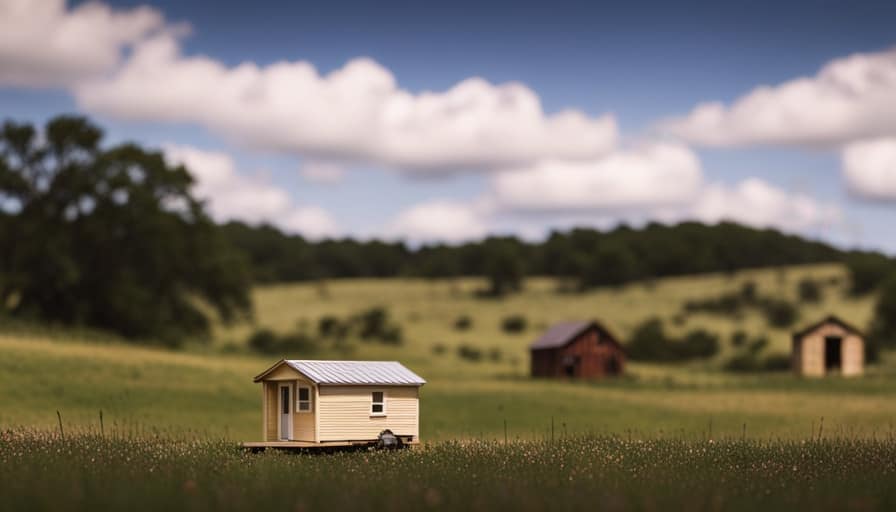
Integrating solar power into an existing electrical system requires some additional components. We’ll need an inverter, which converts the direct current (DC) power generated by the solar panels into alternating current (AC) power that can be used in our household appliances. Additionally, a charge controller is necessary to regulate the flow of electricity between the solar panels and the batteries, ensuring optimal charging and preventing overcharging.
Testing and Regular Maintenance of the Micro-Grid
Regular maintenance of the micro-grid is essential to ensure its optimal performance and longevity. To keep your micro-grid running smoothly, it’s important to follow a regular maintenance schedule and conduct testing procedures. Here are some key steps to include in your maintenance routine:
- Conduct regular inspections of all components, including solar panels, batteries, and inverters, to identify any signs of wear or damage.
- Clean the solar panels regularly to remove dirt and debris that can reduce their efficiency.
- Test the battery performance and voltage levels to ensure they’re functioning properly.
- Check the connections and wiring to ensure there are no loose or damaged parts that could disrupt the flow of electricity.
Frequently Asked Questions
How Long Will It Take for a Solar System to Pay for Itself in Terms of Cost Savings on Energy Bills?
Estimating the return on investment for a solar system in a tiny house depends on several factors. These include the cost of the system, energy usage, and local utility rates. It typically takes several years for the system to pay for itself through energy bill savings.
Can I Still Connect to the Grid and Sell Excess Energy Back to the Utility Company?
Yes, we can still connect to the grid and sell excess energy back to the utility company. However, there are limitations such as grid connection fees and regulations that vary depending on location.

Are There Any Government Incentives or Tax Credits Available for Installing a Solar System in a Tiny House?
Yes, there are government incentives and tax credits available for installing a solar system in a tiny house. These incentives and credits can help offset the cost and make solar power more affordable.
What Kind of Maintenance Is Required for the Solar Panels and Other Components of the Micro-Grid System?
Solar panel maintenance is essential for optimal performance. Regular cleaning and inspection of components ensure longevity and efficiency. We must prioritize proper upkeep to ensure a reliable micro-grid system in our tiny house.
Can I Expand My Solar System in the Future if I Want to Increase My Energy Production Capacity?
Yes, we can expand our solar system in the future to increase our energy production capacity. This allows us to meet our growing energy needs and take advantage of advancements in solar technology.
Conclusion
In conclusion, mastering the micro-grid and harnessing solar power in your tiny house is like becoming the captain of your own ship. By assessing your energy needs, choosing the right solar system, and procuring the necessary components, you can navigate the seas of renewable energy.
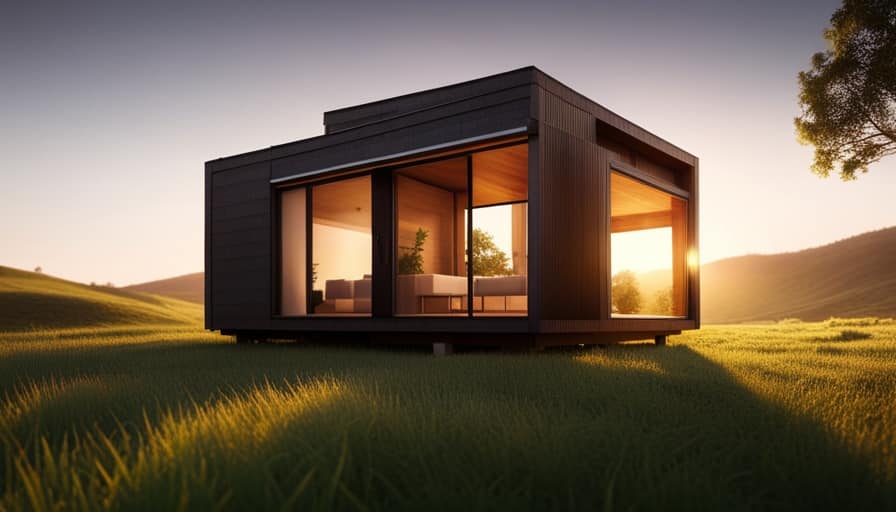
Positioning the solar panels effectively, wiring the system, and setting up the battery system are like hoisting the sails and steering your ship towards a sustainable future.
With regular maintenance, you can keep your micro-grid shipshape and enjoy the benefits of clean, renewable energy.
I’m Theodore, and I love tiny houses. In fact, I’m the author of Tiny House 43, a book about tiny houses that are also tree houses. I think they’re magical places where imaginations can run wild and adventures are just waiting to happen.
While tree houses are often associated with childhood, they can be the perfect adult retreat. They offer a cozy space to relax and unwind, surrounded by nature. And since they’re typically built on stilts or raised platforms, they offer stunning views that traditional homes simply can’t match.
If you’re looking for a unique and romantic getaway, a tree house tiny house might just be the perfect option.






